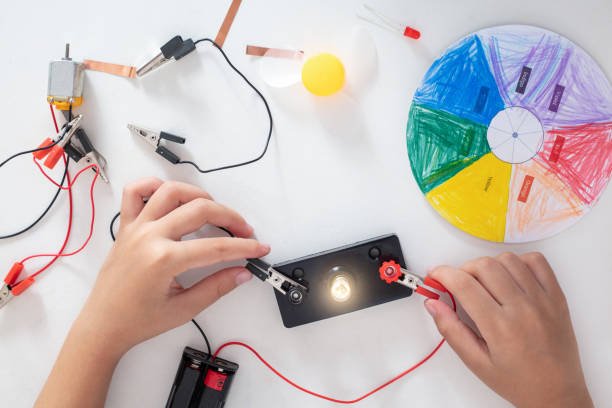Electric Circuits Physical Sciences Grade 11 Notes, Questions and Answers:
Important sections on Electric Circuits Grade 11
As a Grade 11 Physical Science student, you should be able to
- Define current in words.
- State Ohm’s law in words.
- Determine the relationship between current, potential difference and resistance at a constant temperature using a simple circuit.
- State the difference between ohmic conductors and non-ohmic conductors and give an example of each.
- Define power in words.
Questions and Answers
Question 1:
Three 1,5V cells are connected in series to form a battery with negligible internal resistance. Four identical bulbs are connected in the circuit. L1 is connected in series with the battery and an ammeter that reads the current through the battery. L2 and L3 are in connected in series in a parallel branch. L4 is connected in the second parallel branch. A voltmeter, V1, reads the potential difference across the battery and a second voltmeter, V2, reads the potential difference across L4.
- Draw the circuit diagram of the circuit. (5)
- Calculate the reading on the ammeter. (6)
- Calculate the readings on V1 and V2 (4)
- Predict what you would observe about the brightness of the bulbs. Explain your answer by doing some calculations.
Question 2:
A kettle is marked 240 V; 1 500 W.
- Calculate the resistance of the kettle when operating according to the
above specifications. (3) - If the kettle takes 3 minutes to boil some water, calculate the amount of electrical energy transferred to the kettle.
Question 3:
A 10 Ω resistor and a variable resistor (rheostat) are connected in series and placed across a 12 V source. The rheostat is adjusted until the current in the circuit is 0,5 A.
- At what resistance is the rheostat set?
- What is the potential difference across the 10 Ω resistor?
- What is the potential difference across the rheostat?
Watch: Grade 11 Physics: Electric circuits Exam questions
CONDUCTORS AND INSULATORS
An electrostatic force will cause charges to move. If charges can move through a substance, it is called a conductor. If the charge cannot move through a substance, it is called an insulator or a non-conductor.
Conductors:
- Metals are good conductors because their electrons are loosely bonded and can move easily.
- If a solution conducts electricity, it is called an electrolyte.
Insulators:
- Non-metals are very good insulators; their electrons are very tightly bonded and cannot move.
CURRENT ELECTRICITY
This is the movement of charges inside a conductor, e.g. the closed circuit. Electrons are the “carriers” of charge in metals and ion carry charge in solutions.
A closed circuit is needed for a current to flow. A circuit needs at least three components: an electrical source, a conductor, and a resistor. Current can only flow in a closed circuit – a circuit in which there are no “gaps.”
CURRENT
Electric current is the amount of charge that moves past any point in a conductor each second. Electric current can be calculated by using the following equation:
Q=It
1 Coulomb is the amount of charge that moves past a point of a conductor in 1 second when the current in the conductor is 1 ampere. Electric current is measured with an ammeter that is always connected in series.
The direction of conventional current is always from the positive terminal of the cell through the circuit to the negative terminal of the cell.
POTENTIAL DIFFERENCE
A difference in electric potential energy between two points in a circuit is the potential difference across that point.
The potential difference between two points in an electric circuit is the energy transferred (work must be done) when 1 coulomb charge moves from one point to the other.
Potential difference is measured across the components in the circuit where electrical energy is given to the charges (i.e. over the cells) or where electrical energy is “used” or given off by the charges when they move through components (i.e. bulbs or resistors),
A voltmeter is used to measure potential differences. A voltmeter is always connected in parallel over which it measures the potential difference; it has a high resistance. The one end of the connection registers how much energy the charges have when they enter the cell or resistor, the other registers the energy that the charges have when they leave the component. The voltmeter now gives the reading showing the difference in energy across the component.
RESISTANCE
Resistance is caused by collisions in a conductor when a current is flowing through it.
A good conductor has a low resistance.
Electric resistance is the resistance that a conductor offers against the flow of charge.




